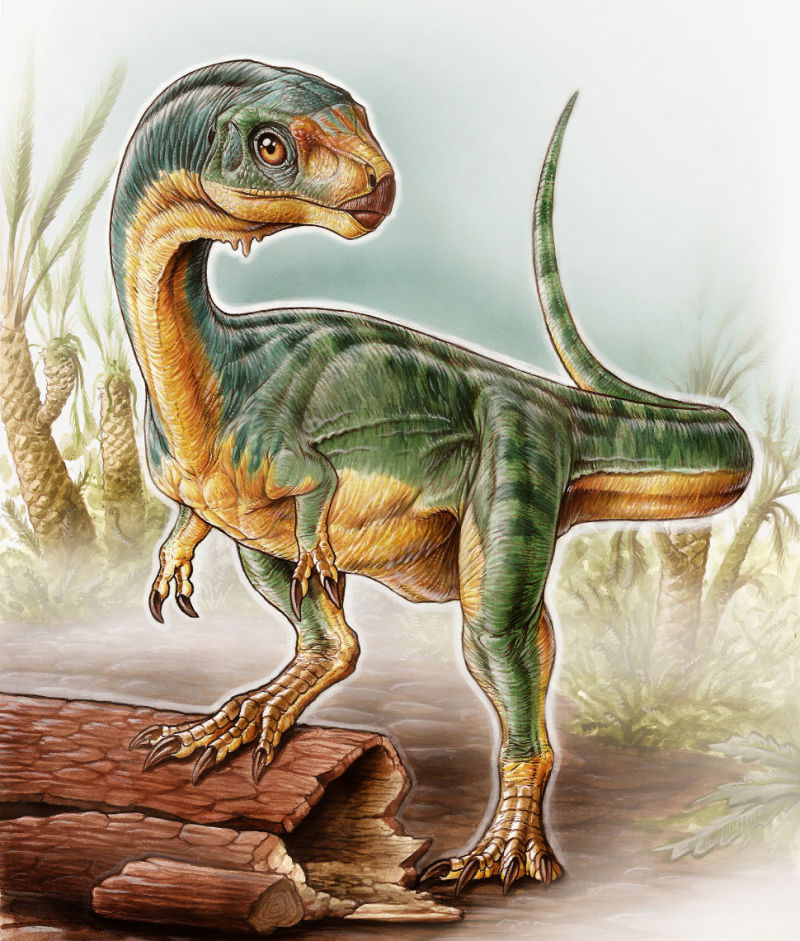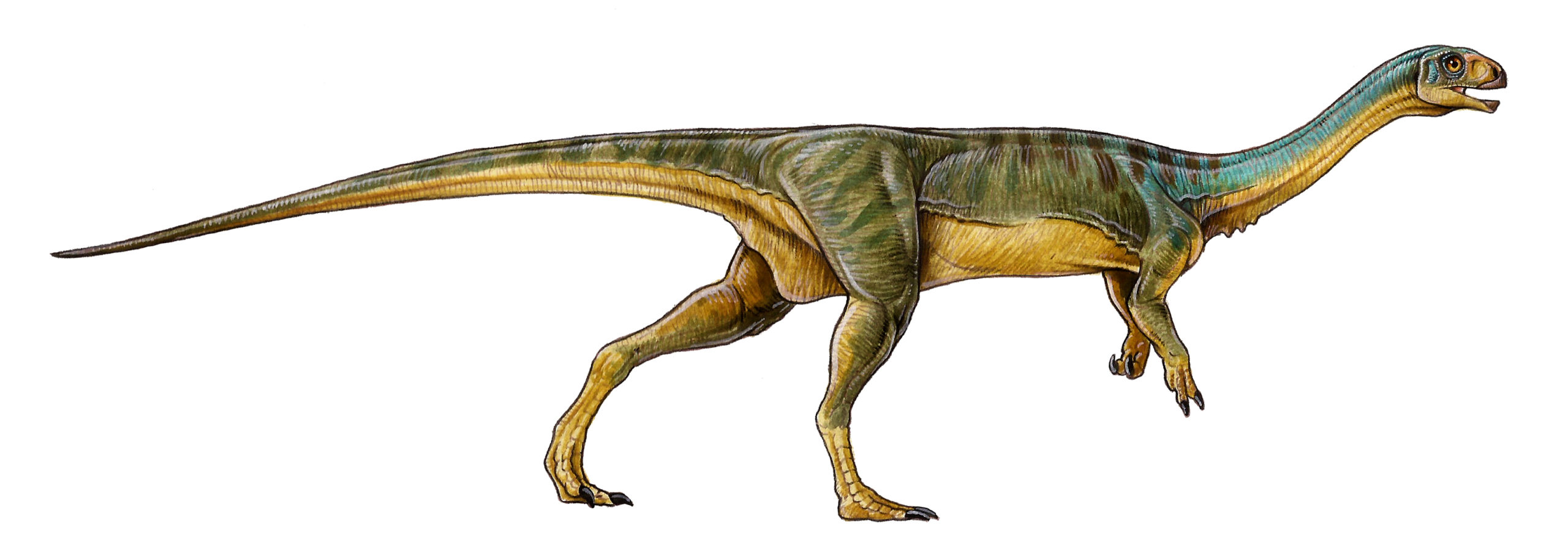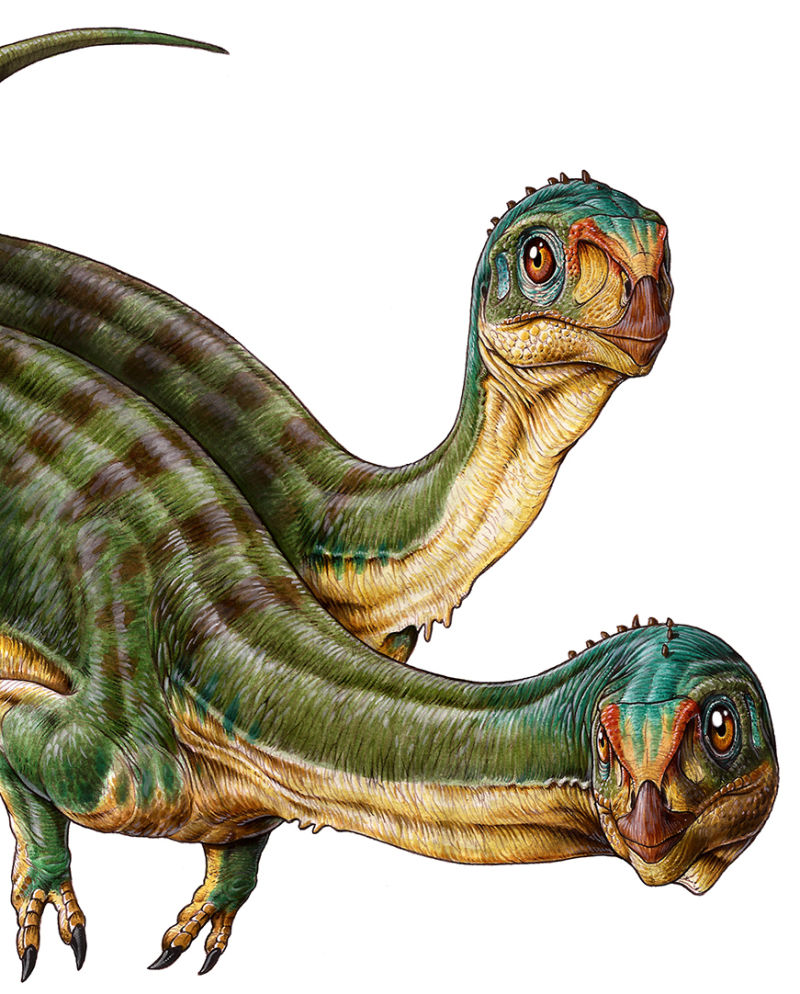Palaeontologists uncovered a strange new dinosaur a few years ago — a crazy, patchwork quilt of a creature dubbed Chilesaurus diegosuarezi. Its bizarre and often conflicting characteristics defied classification, forcing scientists to make an educated guess about its place on the dino family tree. New research suggests the initial attempt to classify Chilesaurus was wrong, and that this animal represents an important transitional species within a different group of dinosaurs.
Image: Gabriel Lio via University of Birmingham
The study, published today in Biology Letters, shows that Chilesaurus is not a theropod, as originally thought, but rather a very early member of ornithischia, a group of that includes beaked plant-munching dinosaurs such as Stegosaurus, Triceratops and Iguanodon. It may sound pedantic, but this taxonomic reshuffling is a big deal to palaeontologists. It means that Chilesaurus, despite its raptor-like appearance, does not belong to a group including infamous carnivores such as Tyrannosaurus rex and Velociraptor. Instead, the animal represents a kind of intermediary species somewhere between herbivorous dinosaurs and carnivorous theropods. The new study shows how the divide between these two important dinosaur lineages may have transpired.
The fossilised remains of Chilesaurus were only recently uncovered in southern Chile, so palaeontologists don’t know very much about it. This bipedal creature lived about 145 million years ago during the Jurassic Period, and it featured a small skull, long neck, and body that extended for about 3m from head to tail. It had the physical appearance of a raptor, but the shape of its teeth and orientation of its hips suggested a herbivorous lifestyle. If anything, this dino looked like it was stitched together from a bunch of different animals, which is why it’s been referred to as “the platypus of dinosaurs”.
The University of Birmingham researchers who first studied Chilesaurus decided to slot it in as a theropod, a group also known as the “lizard-hipped” dinosaurs. But the new study, conducted by researchers from the University of Cambridge and the Natural History Museum, suggests Chilesaurus is a member of the “bird-hipped” ornithischia group.

Image: Gabriel Lio via University of Birmingham
“Dinosaurs have been divided into big groups based on the structure of their hips, but this classification system is now breaking down,” explained professor Paul Barrett of the Natural History Museum, a co-author of the new study, in an interview with Gizmodo. “Theropods have an arrangement of hip bones similar to that in most other reptiles (such as lizards and crocodiles), with one of the bones, called the pubis, pointing downwards and forwards. By contrast, ornithischians have differently-shaped hip regions, where the pubis bone is rotated so that it points downwards and backwards, as also occurs in living birds.”
Confusingly, however, Barrett says this bird-like arrangement appears to have emerged at least twice independently in dinosaur evolution — once in the common ancestor of ornithischians (as is the case for Chilesaurus) and once within theropods, leading to the origin of birds.
Chilesaurus, as the new study suggests, belongs to the ornithischia group of dinos, but it’s still an outlier. Ornithischian bird-hips provided a bodily configuration that was more conducive to complex digestive systems, allowing these plant eaters to travel along a unique evolutionary path. But Chilesaurus, without a characteristic ornithischian beak and with a very raptor-like body, represented an early — and likely transitional — member of this group. It isn’t literally the “missing link” that divides ornithischians from theropods (two major dinosaur groups that lived from the early Jurassic to the Late Cretaceous), but its discovery shows how dinosaurs were changing during this important time in evolution.
The weird combination of features makes Chilesaurus very difficult to classify, and Barrett says previous ideas of it being a theropod are “totally understandable”, as it has many theropod-like features in its anatomy. Matthew Baron, a PhD student in Cambridge’s Department of Earth Sciences and the paper’s joint first author, agrees, saying the original researchers only had smaller, specialised datasets at their disposal, and that they had no way of testing if Chilesaurus was an ornithischian or not. In the new study, Barrett and Baron were able to use a bigger dataset on a larger range of dinosaurs, allowing them to test lots of different positions for Chilesaurus within the dino family tree.
“It’s a good illustration of how continuing work and getting more new information can lead us to change our previous ideas,” Barrett told Gizmodo.

Image: Gabriel Lio via University of Birmingham
“What is nice is that Chilesaurus is a halfway animal, the missing link, between theropod dinosaurs and ornithischian dinosaurs, two groups that, until our study was published, were thought to be unrelated,” Baron told Gizmodo. “We moved the ornithischians over to join the theropods, but had no missing links to show the transition between the groups until Chilesaurus was added.”
Importantly, this new study fits in rather nicely with research that Barrett and Baron completed earlier this year, in which the authors argued that theropods are more closely related to ornithischians than previously thought.
As their latest study points out, dinosaurs can’t always be slotted easily into the major groups owing to the presence or absence of certain characteristics — the orientation of hips being a prime example.
Matt Wedel, a palaeontologist and anatomist at Western University of Health Sciences in Pomona who wasn’t involved in the new study, said the authors did a good job of unpacking the results and explaining the evolutionary importance of Chilesaurus.
“Ornithischian dinosaurs — the horned, dome-headed, armoured, and duckbilled dinos and their early relatives — have been recognised for over a century by a set of specialised features: Pubic bones in the pelvis that tilt backward instead of forward, to make room for a big digestive tract; a predentary bone at the tip of the lower jaw to help support the beak; and tendons along the backbone that had turned to bone, to help support the vertebral column and the big gut,” he told Gizmodo. “Chilesaurus shows that these features didn’t all evolve at the same time. The back-tilted pubis came before the predentary bone or the ossified tendons.”
Wedel says this is how scientists come to understand evolutionary transitions, and that new types of animals “don’t spring formed like Athena from the forehead of Zeus”. Rather, they come together a piece at a time as the result of evolutionary experimentation of thousands of millions of years.

Image: Gabriel Lio via University of Birmingham
“If Baron and Barrett are correct, Chilesaurus is sort of the Archaeopteryx of Ornithischia — it has some, but not all, of the characters that we normally associate with the group, just like Archaeopteryx has feathers but still has a lot of primitive features, too,” he said. Archaeopteryx is a family of bird-like dinosaurs that represents a transition from non-avian feathered dinosaurs to modern birds.
Wedel also offered some advice for journalists covering this new paper.
“Please do not put anything in the title about ‘New dinosaur rewrites evolutionary history’,” he said. “Whenever there’s an evolutionary transition, like land animals to whales, or early theropods to birds, we expect to find transitional forms. What’s exciting here is that Chilesaurus may be one of those transitional forms for one of the largest and most diverse groups of dinosaurs. It’s giving us a window into an area of dinosaur evolution that is still not understood very well.”
And if Barrett and Baron and wrong, well that’s good too, says Wedel. The truth will come to light because of further analyses using more data, he says.
“For now, their work looks solid, and it’s a challenge to the field to test their hypothesis further,” Wedel told Gizmodo. “This is the start of an exciting story in science, not the end.”
